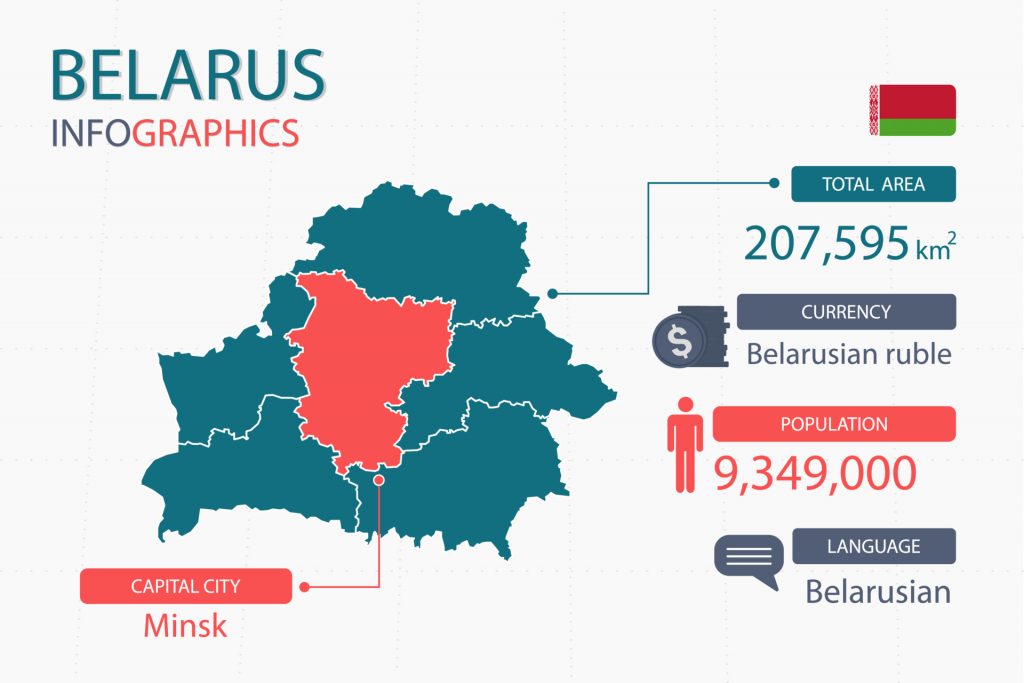The origins of the Belarusian Language
Belarusian is one of the official languages of Belarus. Outside of Belarus, it is also spoken by a large population in the Ukraine and Russia, as well as other countries. In fact, it holds official status in some areas of Poland and it’s a recognized minority language in the Czech Republic, Ukraine, and Lithuania. It is spoken by about 2.5 million people. Regardless of the number of speakers in Belarus itself, many Belarusians in the region use Russian at home and for other purposes.
Belarusian is an East Slavic language. Other languages in this category include Russian and Ukrainian. Indeed, among the other East Slavic languages, Belarusian is largely mutually intelligible, and even among Polish, a Slavic language, there is about 55% mutual intelligibility.
A standardized Belarusian was conventionalized in 1959 and there have only been minor adjustments since then. It displays stark similarities to Russian in terms of grammar, thus partly explaining the two languages’ mutual intelligibility. In general, the word order is subject-verb-object. Belarusian also exhibits the case system, with six cases that all nouns inflect for. Thus, word order is quite flexible, and the order is decided upon the element of a sentence the speaker wishes to emphasize.
Belarusian is written using the Belarusian alphabet, one that is based on the Cyrillic alphabet. The modern Belarusian alphabet has existed since 1918 and contains 32 letters. This version of the alphabet is based on an iteration used in Old Church Slavonic. It is written from left-to-right. While in other languages that employ Cyrillic, spelling is conventionalized by the characteristic of word stems and their origins, Belarusian spelling rules may be considered simpler as spelling rules try to imitate, as much as possible, the manner in which a word is pronounced.

The history of the Belarusian language can be traced back to the 18th century. Before this, Belarusian stemmed from Ruthenian, which is the basis of Ukrainian as well. In the 18th century, Belarusian started to exhibit specific characteristics that differentiated itself from the other East Slavic languages. At this time, it was known as Old Belarusian, and it was the language that a certain number of the nobility used in both writing and speaking. Modern Belarusian is the natural evolution of Old Belarusian. Its development going into the 19th century was influenced by many factors, including political and cultural conflict, especially between the Russian Empire and Polish nobility.
With the Russian Empire and Polish nobility vying for political and cultural influence in Belarusian lands, their respective languages also played an important role in the development of the Belarusian linguistic situation. At the beginning of the 19th century, Polish culture and language was dominant and was held in high esteem, especially among the nobility. As a result, the Belarusian language and culture were not perceived to be of high value. Outside of the nobility, the common people were also very poorly educated and did not hold strong political positions; they did continue to use the Belarusian language but due to their societal status, no prestige was associated with it.
However, in the mid 19th century, the more educated Belarusian segment of the population started to gain social status by establishing themselves in higher positions in the Polish nobility, despite their culture and language still being stigmatized. An example of such discrimination can be the attempt to disseminate Belarusian academic works; a Belarusian grammar was prepared for publication in 1846 but was rejected by the Russian Academy of Sciences. The reason given for the rejection was a lack of scientific rigor.
Regardless of such setbacks, other work had appeared at this time, and a base of literature had begun to emerge, mostly based on the folk language tradition. Meanwhile, Russian and Polish political influences continued to compete in terms of gaining cultural influence. Whereas the rivalry previously presented itself in the nobility and the educated, it spilled to the common folk as well as people in political power recognized that winning the hearts of commoners can be a game changer in terms of cultural capital. The majority of the common folk used Belarusian, and thus, connecting with them at the linguistic level because of the priority for both Russian and Polish influencers. Thus, instead of the language being looked down upon as a country dialect, propaganda efforts from both sides specifically targeted Belarusian peasants; much of this propaganda was published in Belarusian as a specific strategy to build rapport. This caused a unique linguistic phenomenon in Belarus – in urban areas, Russian or Polish was quite prominent in everyday usage, and in more rural areas and parts of Belarus where the peasantry lived, Belarusian was more prominent.
In 1904, due to the influence of Socialist ideas, a ban on publications in Belarus was officially removed. At this time, Belarusian literature began to flourish and many publications began to emerge. During the earlier 20th century, Belarusian grammatical conventions began to form and various scholars started to codify them more systematically in grammars.
When part of Belarus was considered Soviet Union territory, Belarusian had equal status with three other languages: Russian, Polish, and Yiddish. However, West Belarus, under Polish control, still had linguistic policies that tried to limit the use of Belarusian; Belarusian publishing institutions were suppressed and the language was discouraged in terms of its use in education, the public sphere, and general media.Throughout the World Wars, different degrees of support and oppression of the language occurred, but the language developed under different efforts. However, it never became a strong national language due to the way Belarusian lands were either divided or occupied.
Belarus gained its independence in 1991. At this time, The language finally gained a status of prestige when it became the official state language. However, in 1995 a referendum decreed that Russian was also of equal status. Nowadays, the Belarusian language, while recognized for its cultural significance is not the language that is most spoken in Belarus due to its long history of being suppressed. The Belarusian speaking community in Belarus is far from the majority, and thus the language is not quite as widely used as Russian.
As a minority community, education in Belarusian is not widespread. In fact, there are no Belarusian-language universities in the country, as Russian is the main language of education. Most recently, there have been concentrated efforts to raise the prestige of Belarusian by language institutions. There is support from public figures, language societies, and social institutions and this has spurred an interest in young people to continue to learn the language and utilize it in everyday life.
However, as the Government tends to use Russian in public processes and administrative documentation, any attempt to widen Belarusian language and culture is viewed as political rivalry and is punished as such.
VEQTA can provide you with a perfect Belarusian translator for your Belarusian translation, English to Belarusian translation and Belarusian to english translation for the your targeted locale. Our translations to Belarusian are created with your target audience in mind to meet your expectations.
If you need to translate Belarusian – Get in touch today!
A dedicated team of Belarusian translators who combines Experience, Specialized Subject Matter Expertise with Translation Practices to deliver quality second to none.
Belarusian Subject Expertise
Belarusian Translators
Belarusian Editors
Belarusian Copywriters
Belarusian Reviewers
Belarusian Voice dubbing
Belarusian Subtitling
Belarusian Transcription


